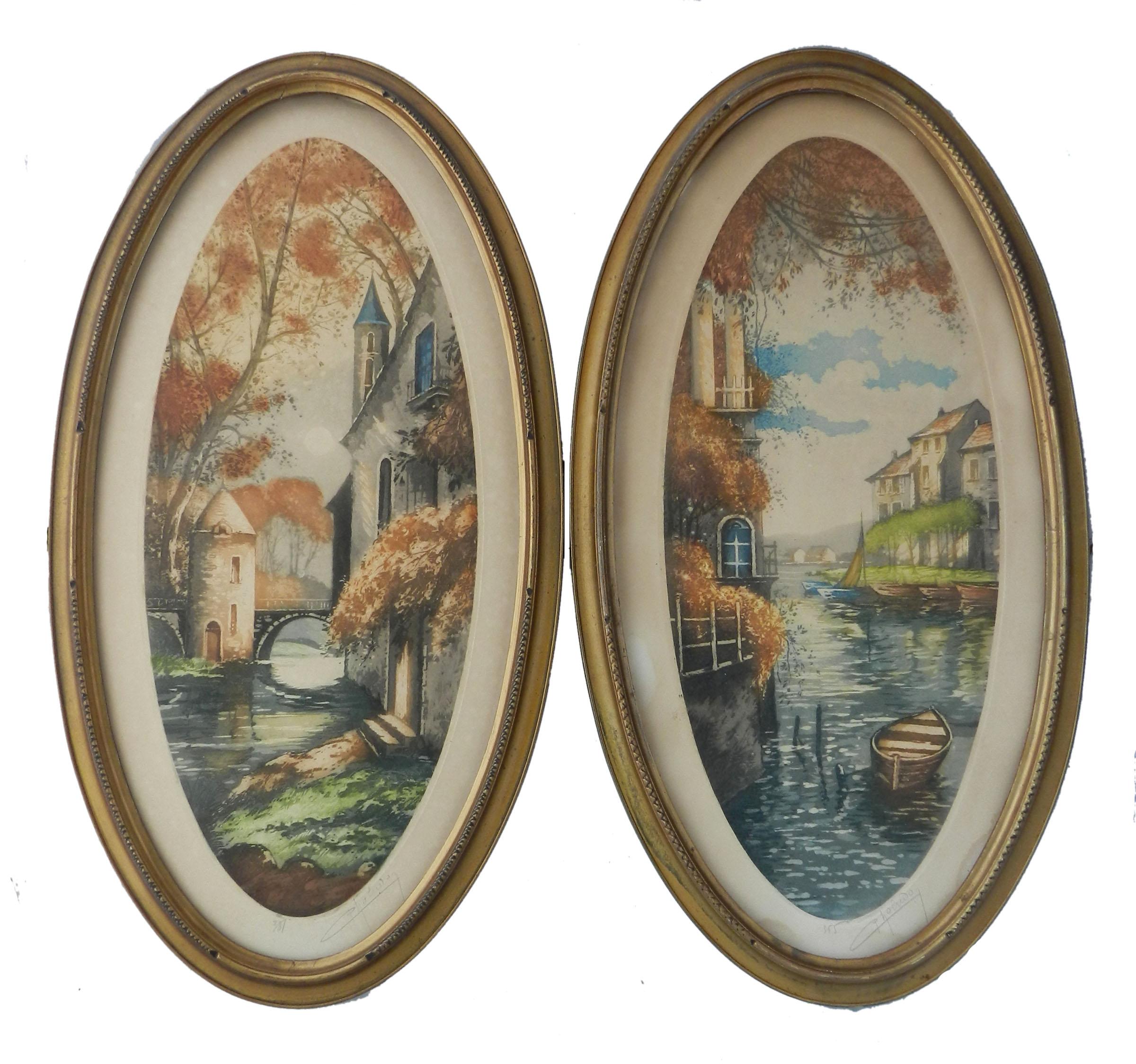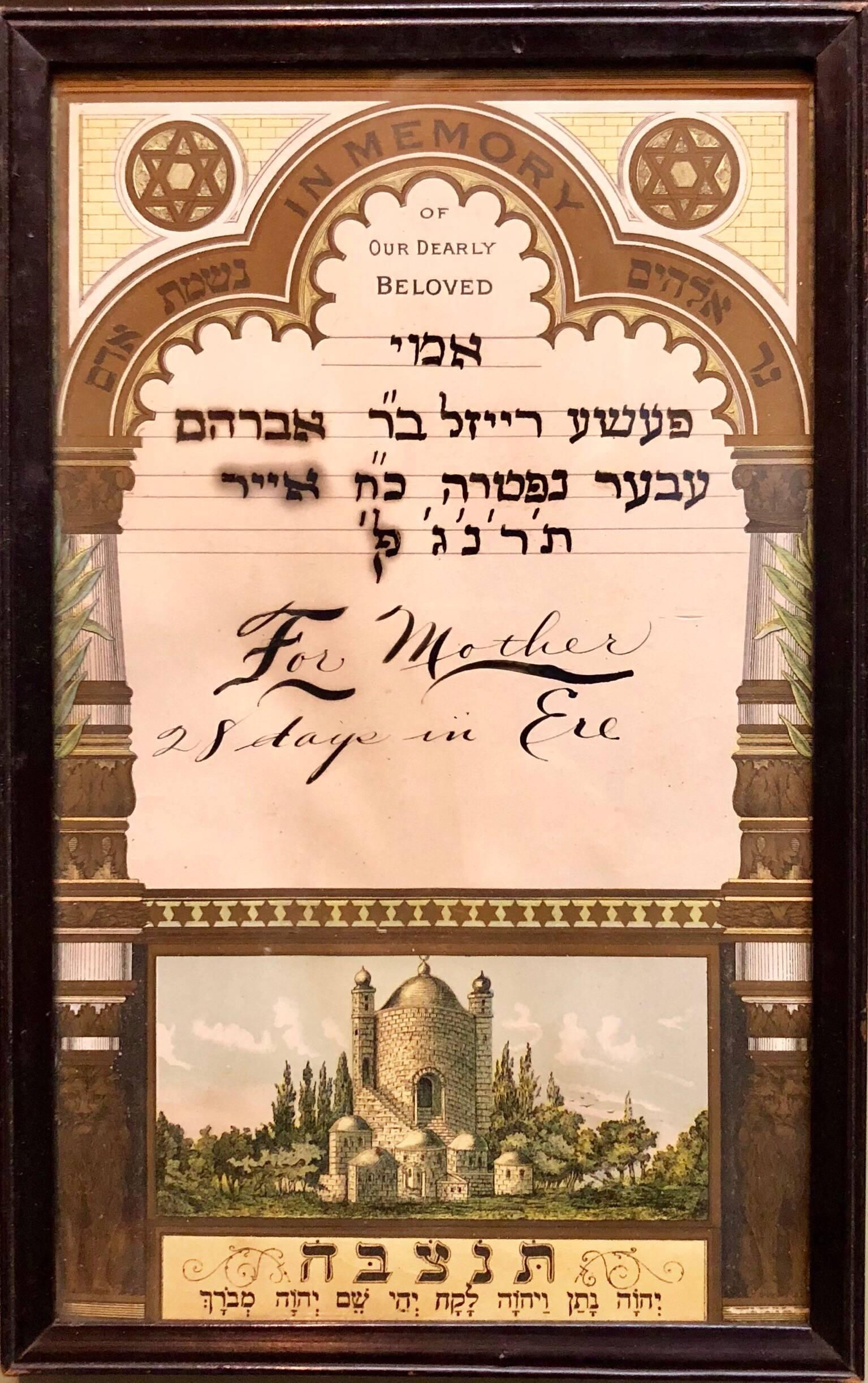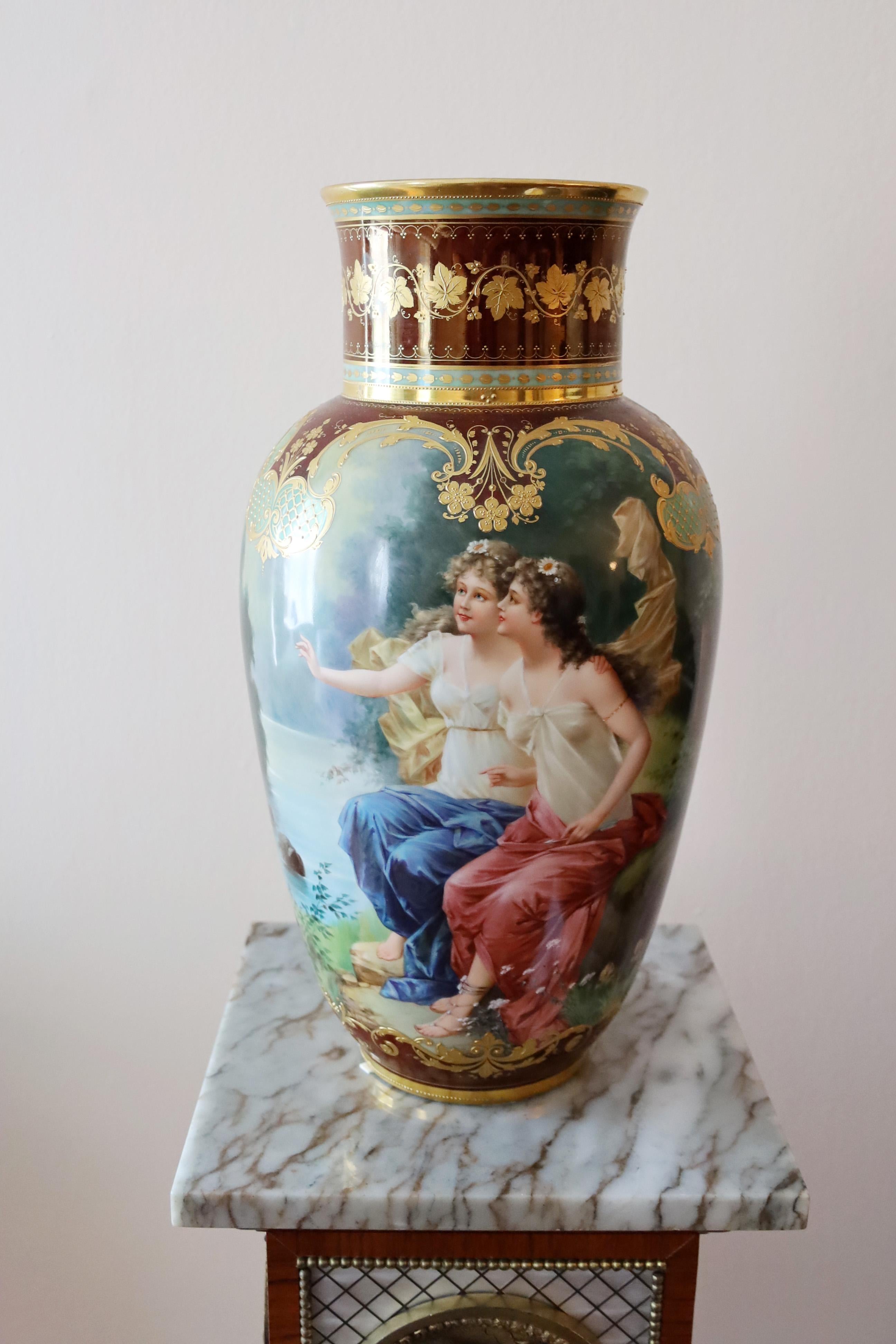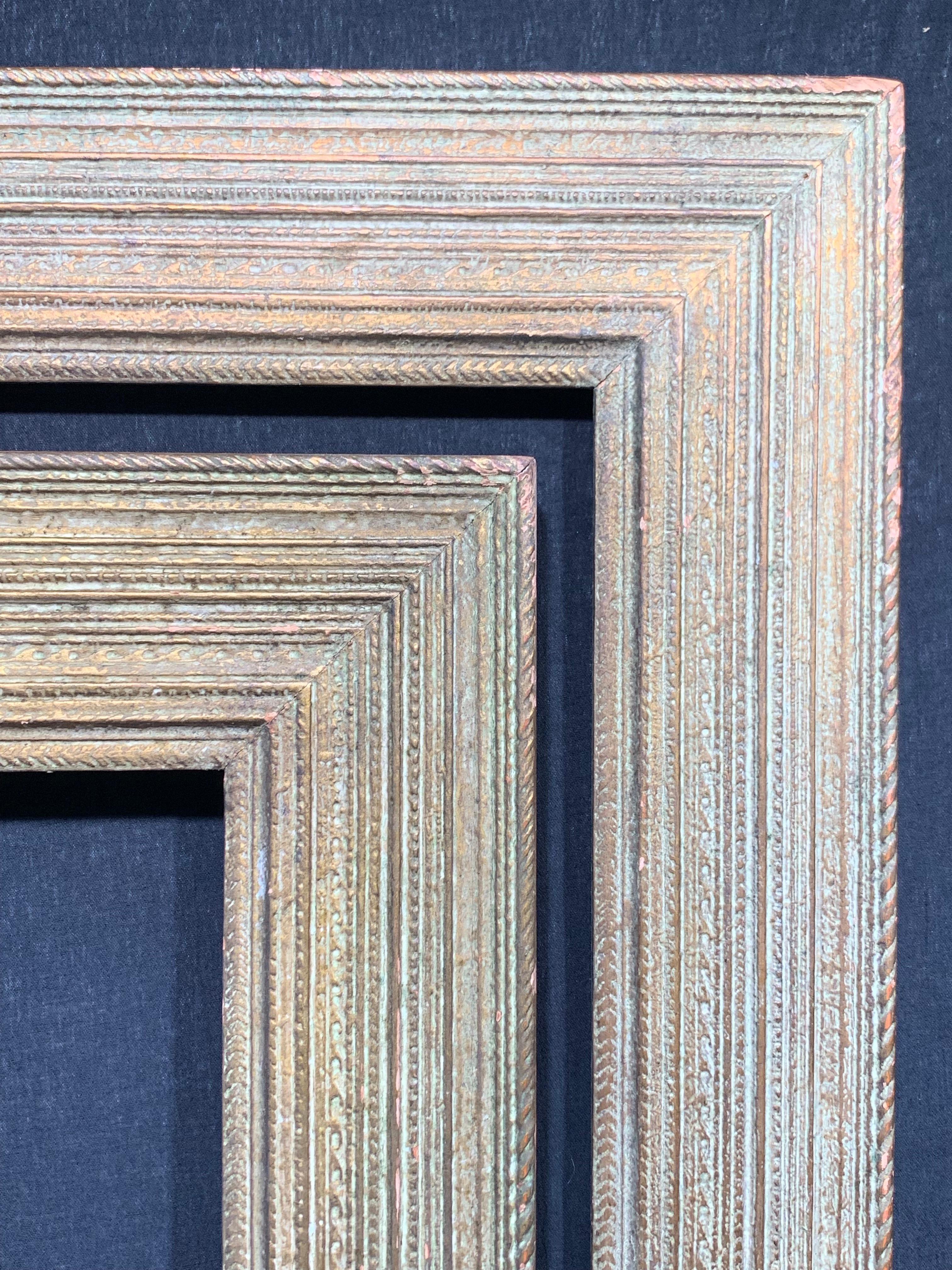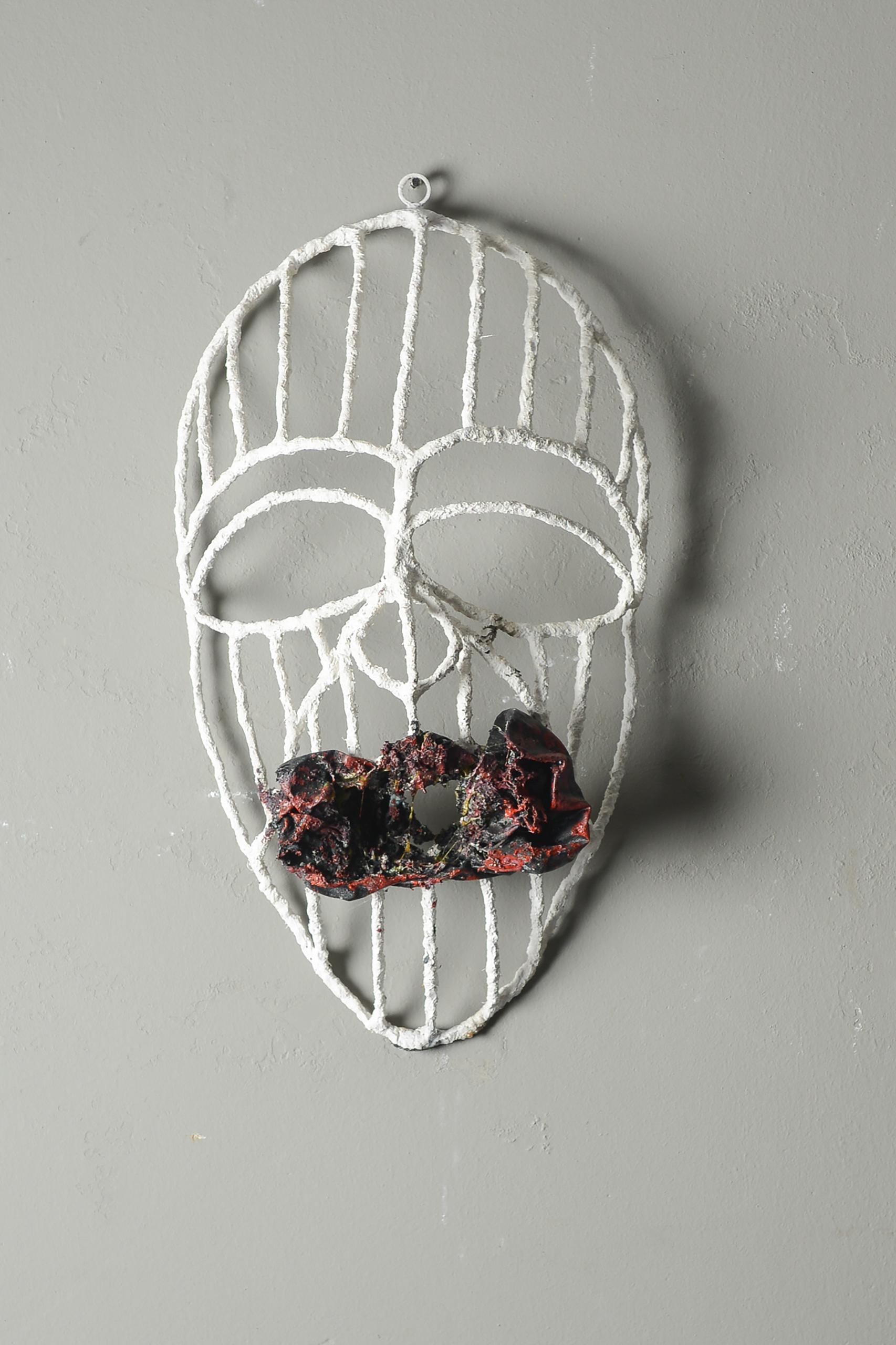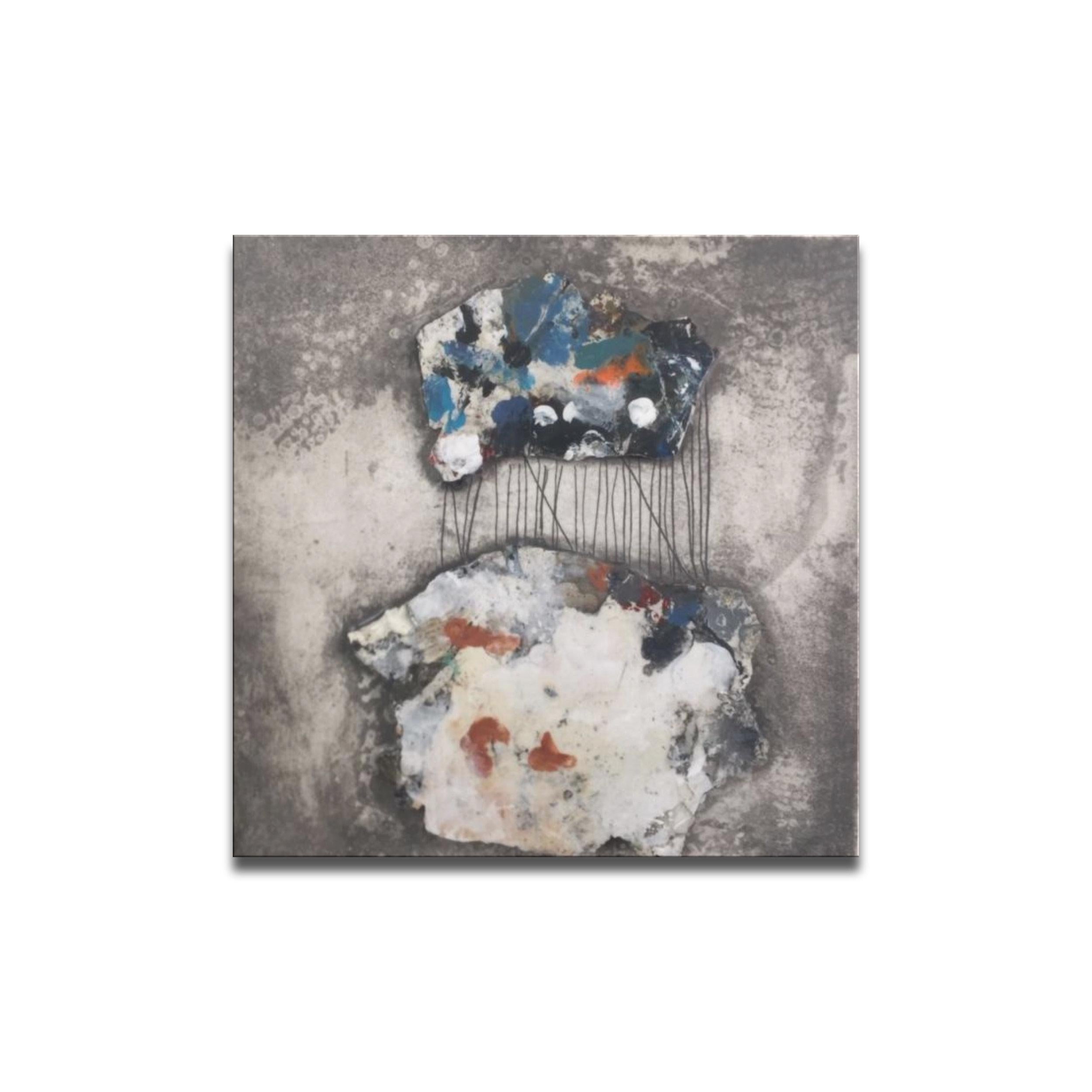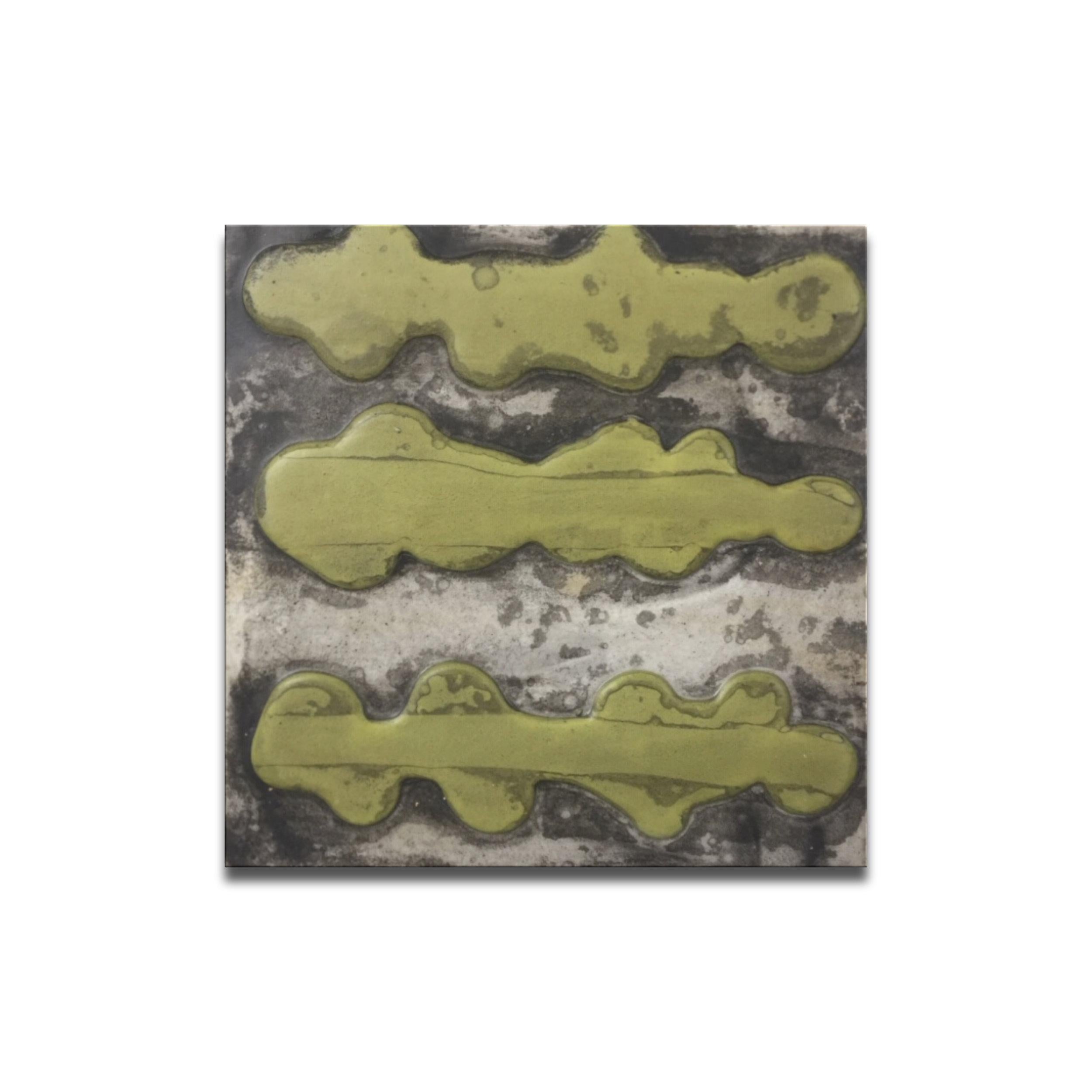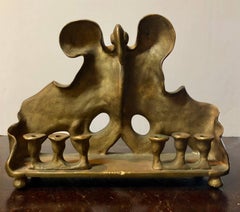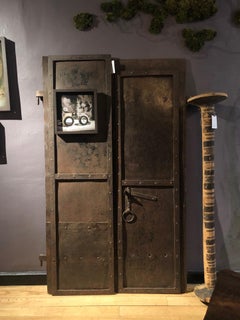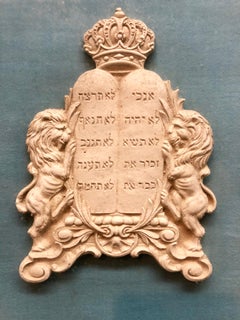
Framed Antique Judaica Plaster Ten Commandments Hebrew Sculpture Plaque
View Similar Items
Want more images or videos?
Request additional images or videos from the seller
1 of 5
UnknownFramed Antique Judaica Plaster Ten Commandments Hebrew Sculpture Plaque c.1910
c.1910
About the Item
- Creation Year:c.1910
- Dimensions:Height: 13.5 in (34.29 cm)Width: 11.5 in (29.21 cm)
- Medium:
- Movement & Style:
- Period:
- Condition:needs new mat and frame, frame has extensive wear size includes frame.
- Gallery Location:Surfside, FL
- Reference Number:1stDibs: LU3823201021
About the Seller
4.9
Platinum Seller
These expertly vetted sellers are 1stDibs' most experienced sellers and are rated highest by our customers.
Established in 1995
1stDibs seller since 2014
1,555 sales on 1stDibs
Typical response time: 1 hour
More From This SellerView All
- Rare Judaica 1893 Jewish Yizkor Memorial Plaque Hebrew English ChromolithographLocated in Surfside, FLA rare Judaic memorial piece for mother.Category
Late 19th Century Aesthetic Movement More Prints
MaterialsLithograph
- Rare Palestine Antique Hebrew Judaica Yahrzeit Synagogue Sign Memorial PlaqueLocated in Surfside, FLCirca 1890-1920. This Neoclassical, Judaic, Egyptian revival, Orientalist Mizrach sign, was produced in British Mandate Palestine by the chromolithograph process at the beginning of the 20th century. It pictures vignettes of holy places. with a hand written memorial. It was for the Tzedakah charity fund for the century-old institutions in Jerusalem: The great "Torah Center Etz Chaim"; a Free Kitchen for poor children and orphans; the famous Bikur Cholim Hospital with its dispensaries and clinics and the only Home for Incurable Invalids in Eretz Israel. They also worked with Arthur Szyk and Alfred Salzmann.. The A.L. Monsohn Lithographic Press (Monzon Press, Monson Press, דפוס אבן א"ל מאנזאהן, דפוס מונזון) was established in Jerusalem in 1892 by Abraham-Leib (or Avrom-Leyb) Monsohn II (Jerusalem, c.1871-1930) and his brother Moshe-Mordechai (Meyshe-Mordkhe). Sponsored by members of the Hamburger family, the brothers had been sent to Frankfurt, Germany in 1890 to study lithography. Upon returning to Jerusalem in 1892 with a hand press, they established the A.L. Monsohn Lithographic Press in the Old City of Jerusalem. According to the Information Center for Israeli Art A.L. Monsohn "created complex decorations for documents and oriental calendars that combined the tradition of Jewish art with modern printing techniques such as photographic lithography, raised printing and gilding." The founders of the Monsohn press produced Jewish-themed color postcards, greeting cards, Jewish National Fund stamps, and maps documenting the evolution of the Jewish settlement in Eretz Israel in the nineteenth-twentieth centuries; religious material such as decorative plaques for synagogues, portraits of Old Yishuv rabbis such as Shmuel Salant, Mizrah posters indicating the direction of prayer for synagogues, memorial posters, and posters for Sukkot booths; color frontispieces for books such as Pentateuch volumes and the early song collections of Abraham Zvi Idelsohn (e.g., Shire Zion, Jerusalem 1908); artistic wedding invitations; and labels, packaging and advertisements for the pioneering entrepreneurs of Eretz Israel. The texts appearing in the Monsohn products were in several languages: Hebrew, Arabic, Yiddish, English, German (e.g., a c1920 trilingual Hebrew-English-Arabic "Malaria Danger" broadside warning the public of mosquitoes spreading malaria). Many of the brilliantly colored postcards and maps can be seen online as can the artistic invitations to his children's weddings which Monsohn published in the Jerusalem Hebrew press. For years, the Monsohn (later, Monson/Monzon) Press was considered the best and most innovative in the country—pioneering in such techniques as gold-embossing and offset printing, among others. Early items for tourists included collections of Flowers of the Holy Land (c. 1910–1918)—pressed local flowers accompanied by scenes from the Eretz Israel countryside and relevant verses from the Bible, edited by Jsac Chagise (or Itzhak Haggis), an immigrant from Vitebsk, and bound in carved olive wood boards. Shortly after World War I Monsohn (now spelled מונזון) used zincography to produce the prints included in the Hebrew Gannenu educational booklets for young children illustrated by Ze'ev Raban of the Bezalel Academy of Art and Design and printed in Jerusalem by Hayim Refael Hakohen (vol. 1, 1919; vols. 2–3, 1920). In 1934 Monsohn moved into the new, western part of Jerusalem, in a shop with four presses and 30 workers, including Abraham-Leib's sons, David, Yosef, Moshe and Shimon, and his daughter Raytse's husband, Abraham Barmacz. The concern did business with all sectors of the city's population, including Arabs, for whom they printed in Arabic. Among their clients were members of the Ginio, Havilio, and Elite families, and Shemen, Dubek, and other renowned national brands, manufacturing products such as wine, candies, oil, and cigarettes. They also printed movie and travel posters, and government posters, postcards and documents, hotel luggage labels...Category
Early 20th Century Aesthetic Movement More Art
MaterialsLithograph
- RARE Judaica Holocaust Memorial Menorah Bronze SculptureBy Mosheh OvedLocated in Surfside, FLMoshe Oved (aka Edward Good) was a Polish-British, jeweler, artist, sculptor and Yiddish author and founder of the antique jewelry shop Cameo ...Category
Early 20th Century Aesthetic Movement Figurative Sculptures
MaterialsBronze
- RARE Judaica Brutalist Animal Holocaust Memorial Menorah Bronze SculptureBy Mosheh OvedLocated in Surfside, FLMoshe Oved (aka Edward Good) was a Polish-British, jeweler, artist, sculptor and Yiddish author and founder of the antique jewelry shop Cameo Corner. He le...Category
Early 20th Century Aesthetic Movement Figurative Sculptures
MaterialsBronze
- Plaster Sculpture Relief Art Deco Plaque WPA Artist Peace Swords to PloughsharesBy George AaronsLocated in Surfside, FLSize includes wood mounting. George Aarons (born Gregory Podubisky, in St. Petersburg, Russia, 1896 - died in Gloucester, Massachusetts 1980) was a distinguished sculptor who lived and taught in Gloucester, Massachusetts, for many years until his death in 1980. He had, many students in the area and he designed Gloucester's 350th Anniversary Commemorative Medal. Aarons moved from Russia to the United States when he was ten. His father was a merchant. He began taking drawing classes during evenings at Dearborn Public School in Boston as a teenager and went on to study at the Boston Museum of Fine Arts in 1916. Aarons later moved to New York City to study with Jo Davidson, and other Paris-trained masters at the Beaux-Arts Institute. He eventually returned to the Boston area and established studios in Brookline and Gloucester, Massachusetts. During his lifetime, he was recognized internationally and won several prestigious awards. Aarons had studios in Brookline, Massachusetts and Gloucester, Massachusetts where he produced large bronze and marble figures and wood carvings. He produced several projects for the Works Progress Administration including a group of three figures for the Public Garden (Boston), a longshoreman, fisherman and foundry worker, as well as a large relief (1938) for the South Boston Housing Project and façade of the Baltimore Hebrew Congregational Building (1956). His works are at the Museum of Art in Ein Harod, Israel; Fitchburg Art Museum in Massachusetts, Musée de St. Denis in France; Hilles Library at Radcliffe College in Cambridge, Massachusetts; and Hillel House at Boston University in Massachusetts. He did reliefs for Siefer Hall at Brandeis University in Waltham, Massachusetts (1950); Edward Filene (the founder of Filene's Department Store and a philanthropist) on the Boston Common; Fireman's Memorial in Beverly, Massachusetts; a memorial to Mitchell Frieman in Boston; the U.S. Post Office in Ripley, Mississippi; and at the Cincinnati Telephone Building; the Combined Jewish Philanthropies building in Boston (1965); and a commemorative medal for the 350th Anniversary of the City of Gloucester, Massachusetts (1972). Characteristic of his era, George Aarons was among the foreign-born American sculptors of the early 20th century who started their careers as academicians and evolved into modernists and increasingly abstract artists. Over thirty pieces spanning the length of this sculptor's career were featured in this exhibition, including work in various medium bronze, wood and original plasters. Like his contemporaries, Aarons experimented with direct carving in wood, and he was one of the few academically trained sculptors who consistently cut his own works in marble. His early work was classically inspired figurative work, along with sensitive portraits. Some of his most powerful sculpture comes from his middle period, when he worked through his emotional pain following the global realization of the Jewish Holocaust. He depicted humanity deep anxiety over this tragedy with figures that are at once symbolically charged and movingly beautiful. Aarons late work consists of radically simplified forms that continue to reference the human form and often are carved directly in wood and stone. Aarons summered and taught classes on Cape Ann for many years before moving to Gloucester full-time with his wife about 1950. While Aarons is best known locally for his domestic-scale works, he also executed numerous monumental, public commissions that can be found throughout the United States in cities such as Washington, D.C.; Baltimore, Maryland; and Cincinnati, Ohio; as well as in France and Israel. As noted in a Gloucester Daily Times Article, Aarons wanted his sculptures to honor the struggles and nobility of people and rail against the evil done against them. And that was why, even as his work grew more and more abstract, stylized and simplified, he never left behind the form of the human figure that had been his focus from his earliest works. Aarons told the Gloucester Daily Times in September 1954 that he found it hard to remember at just what age he started studying art, but he recalled that the nude model had to partially dress when he was in class because he was so young. He initially studied painting and drawing at the museum school, but he once said he became fascinated by sculpture when he met an established sculptor at the Copley Society in Boston who invited Aarons to his studio and offered him some clay to "play around" with. After he graduated, he apprenticed under sculptors Richard Brooks, Robert Baker and Solon Borglum. He worked as a carpenter, shipbuilder, dishwasher and chimney sweep. He fashioned architectural decorations, including figures for fountains and now and then a few commissioned portraits. He returned to Boston by the early 1920s and began to exhibit his own works and get commissions for portraits, fountains and reliefs. His sculptures from this time are dreamy and romantic in the realistic, academic style of the time. A painted portrait of the young Aarons that is included in the North Shore Arts Association exhibit shows a determined fellow with dark brown hair, a suit and bow tie. However, in 1922, this determined young artist was living with his parents on Calder Street in Dorchester. In the 1930s, Aarons adopted the streamlined, monumental style of the socialist works of the time. Aarons made money, as he would all his life, from commissions, selling his personal work and teaching sculpture, but the Depression of the 1930s was tough for everyone. So Aarons found work though the federal Works Progress Administration, one of Franklin Roosevelt's New Deal programs. He received his first major commission when he was asked to create a public sculpture for the South Boston Harbor Village public housing project around 1937. He was elevated to the position of supervisor for the project and received a corresponding $5 pay increase to make his weekly salary $32. The raise convinced him he was fit to marry and he proposed to Gertrude Band, an attractive brunette dancer whom he had been dating for more than a year. They were married before the Harbor Village project was dedicated on Labor Day 1938. Aarons' design featured a brawny, larger-than-lifesize fisherman, longshoreman and a laborer flanked by a boy and girl at either end to portray the children who would live in the apartments. Aarons elected to do the piece in cast stone to employ carpenters and laborers as well as craftsman for a total of 10 men. In his sculpture, Aarons focused more and more on the theme of oppressed people as he worried about the spread of fascism and Nazism during the 1930s, World War II and after. He had done pieces during the mid-1930s about the oppression of African-Americans, including "Negro Head," which is in the North Shore Art Association retrospective. After the war, he also delved into Jewish themes and became increasingly known as an important Jewish artist, leading to commissions from Jewish organizations across the country and abroad. "He gets into raw emotion. Some people describe him as an expressionist because of the emotion (in his work)," Reynolds says. But Aarons, also sculpted sensual sexual nudes...Category
20th Century Art Deco Figurative Sculptures
MaterialsPlaster, Wood
- French Painted Maquette for Sculpture Judaica Klezmer MusicianBy Mane KatzLocated in Surfside, FLMane-Katz (1894-1962) maquette plaster relief for bronze sculpture. (it is made from sort of composite material and then painted or colored from the casting. there is no foundry mar...Category
20th Century Modern Figurative Sculptures
MaterialsPlaster, Paint
You May Also LikeView All
- Pair French Chateau Landscape Signed by Artist Lithograph c1920Located in FRPair of Landscape with Chateau signed by artist Lithograph These have their own frame of the time slightly distressed and glorious Good vintage conditionCategory
1920s Aesthetic Movement Landscape Prints
MaterialsLithograph
- Pair French Chateau Landscape (1) Signed by Artist Lithographs c1920Located in FRPair of Landscape with Chateau (1) signed by artist Lithograph c1920 These have their own frame of the time slightly distressed and glorious Good vintage conditionCategory
1920s Aesthetic Movement Landscape Prints
MaterialsLithograph
- Reclaimed Waxed Warehouse Shutters, Soho, NY 1999 Home FurnishingLocated in Hudson, NYA NEW COLLABORATION Tina West + Tucker Robbins 2020 The Robin Rice Gallery is pleased to present a photographic exhibition by Tina West, featuring a special new collaboration betwe...Category
2010s Aesthetic Movement More Art
MaterialsIron
- MONUMENTAL ROYAL VIENNA PORTRAIT VASE PORCELAIN HANDPAINTED 19TH CENTURYLocated in Forest Hills, NYMONUMENTAL ROYAL VIENNA PORTRAIT VASE - PORCELAIN - HAND PAINTED YOUNG GIRL Inscibed "Erwartung" , Germany, and The Royal Vienna porcelain s...Category
1980s Aesthetic Movement More Art
MaterialsPorcelain
$5,600 Sale Price20% Off - Stanford White Newcomb-Macklin picture frame pairBy Stanford WhiteLocated in Wilton Manors, FLPERIOD FRAMES c. 1915 American painting frame pair, (earlier Stanford White design), Newcomb-Macklin, New York makers, gold leaf, gray bole, gesso, on c...Category
Early 20th Century Aesthetic Movement More Art
MaterialsGold Leaf
$2,400 Sale Price60% Off - Reclaimed freedom of speech 2, Elisia Nghidishange, wire, plaster, fabricBy Elisia NghidishangeLocated in Windhoek, NAReclaimed freedom of speech 2, 2020. Mixed media Elisia Nghidishange was born in Eenhana in northern Namibia. This printmaker, sculptor and mixed me...Category
21st Century and Contemporary Contemporary More Art
MaterialsWire
Recently Viewed
View AllMore Ways To Browse
G C Porcelain
Hebrew Prayer
Contemporary Menorah
Jewish Shabbat
Antique Hanukkah Menorah
Antique Judaica Silver
Antique Silver Judaica
Antique Spice Set
Silver Hanukkah
Plaster Lamps Antique
Antique Hebrew Bible
Antique Brass Menorah
Box Judaica
Silver Prayer Box
Antique Brass Library Lamp
Silver Plated Bible
Antique British Pewter
Antique Chinese Porcelain Plaque

